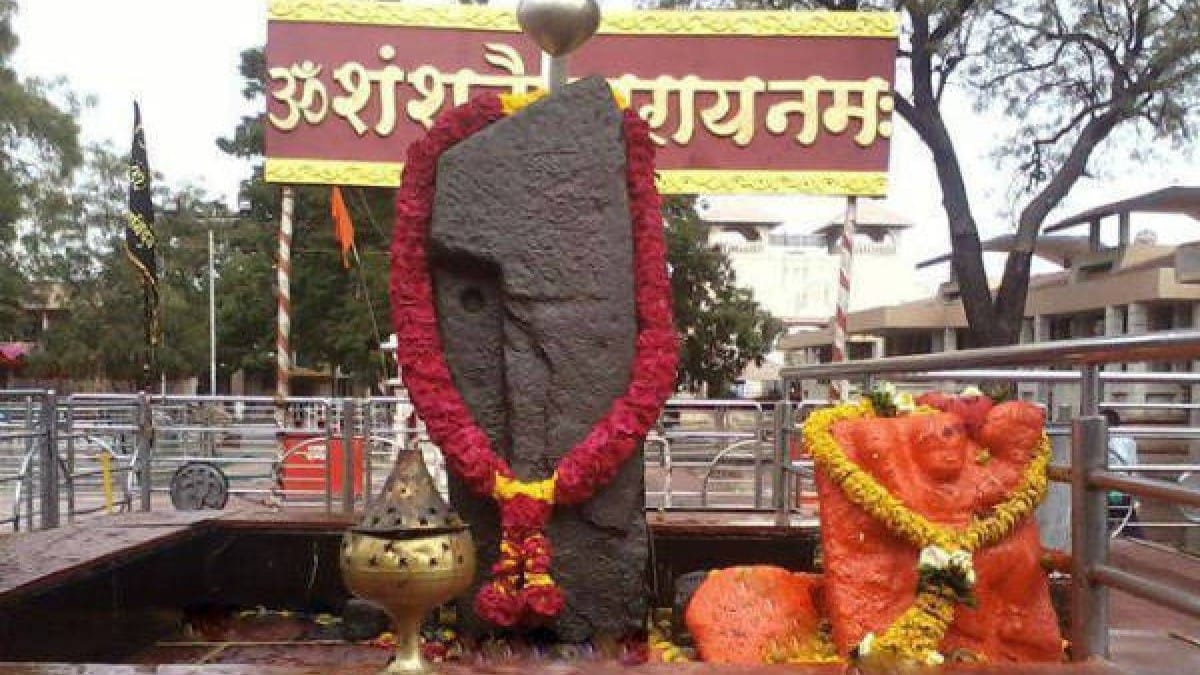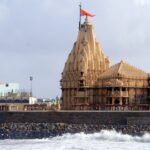The well-known Shani temple can be found in the tiny village of Shani Shignapur in the Indian state of Maharashtra. This sanctuary is devoted to Ruler Shani, otherwise called Saturn in Hindu folklore, and is accepted to be one of the most impressive and respected journey locales in India. The legend of the self-rising Shani idol, which has contributed to the temple’s popularity, and the fact that it does not have any doors or locks make it unique. Fans rush to Shani Shignapur from everywhere the world to look for endowments and offer their appreciation to Ruler Shani, and the town has turned into a significant social milestone in India. In this blog post, we’ll talk about Shani Shignapur’s history, myths, rituals, and special qualities. We’ll also give advice to people who want to go to this fascinating place.
Location and History
Shani Shignapur is about 35 kilometers away from the city of Ahmednagar in the Maharashtra district of India. The town is arranged on the Ahmednagar-Aurangabad thruway and is effectively available by street.

Shani Shignapur’s history dates back to ancient times and includes references to the Hindu deity Shani. It is believed that a shepherd built the Shani temple in Shignapur many centuries ago. According to local legend, the shepherd discovered a black stone among his flock members and attempted to strike it with a stone, but the stone began to bleed. Over the long run, individuals started to accept that the stone was a sign of Master Shani, and the sanctuary was worked around it. Since then, devotees who seek Lord Shani’s blessings make the temple a significant site of pilgrimage.
In comparison to other Indian temples, the history of the Shani temple in Shignapur is unique. Despite the temple not having any doors or locks, the village has never heard of any theft or robbery. It is held that Lord Shani will retaliate against anyone who tries to steal from the village or the temple, which discourages criminal activity. People of all religions have coexisted peacefully in the village and temple, which has earned them a reputation as well.
The Legend of the Self-Rising Idol
The legend of oneself rising symbol of Shani is a well known story related with the sanctuary at Shani Shignapur. As per the legend, the first icon of Master Shani was tracked down by a shepherd in a close by backwoods. To his surprise, the stone began to bleed after the shepherd attempted to strike it with a stick. In the shepherd’s dream shortly thereafter, Lord Shani appeared and instructed him to construct a temple in the same spot where he had discovered the stone.

The shepherd and the other villagers then constructed a modest temple in which they erected the stone to serve as Lord Shani’s idol. However, the idol had a singular feature: whenever the villagers attempted to construct a roof over it, it would rise above the ground. They eventually came to the conclusion that Lord Shani did not desire a roof over his head, and as a result, they left the idol outside the temple, where it remained exposed to the elements.
The temple was rebuilt and expanded over time, but the idol was left outside without a roof or cover. The Lord Shani idol remains outside under the open sky in the current temple, which does not have any doors or locks. Devotees of the temple believe that Lord Shani is a powerful and just deity who cannot be contained by human structures or material possessions due to the legend of the self-rising idol.
Unique Features of the Temple
Shani Shignapur Temple stands out from other Indian temples due to a number of distinctive features. The following are some notable characteristics:
No Doors or Locks: The sanctuary has no entryways or locks, which is surprising for a strict site in India. Devotees hold the belief that Lord Shani watches over the temple and the village, and that he will punish anyone who tries to steal or commit a crime in the area.
Open to the Heavens: Outside of the temple, there is an open-air idol of Lord Shani. Devotees hold the belief that Lord Shani is a powerful and just deity who defies human boundaries.
Oil Abhishekam: Devotees offer prayers and take an abhishekam, or ritual bath, made of oil, especially sesame oil, which is thought to be healing and purifying.
No Discrimination: People of all faiths and backgrounds are welcome to visit the temple and village, which is known for its inclusiveness.
No Commercial Activity: The Shani Shignapur temple, unlike many others in India, does not engage in any form of commercial activity. There are no shops or vendors selling prasad (offerings) or souvenirs.
Peaceful Coexistence: People of all religions and castes coexist peacefully in the Shani Shignapur village, which is well-known for this.
These novel highlights have made the sanctuary at Shani Shignapur a critical site of journey for fans looking for gifts from Master Shani.
Festivals and Rituals
Throughout the course of the year, the temple at Shani Shignapur hosts a number of festivals during which devotees from all over the world come to offer prayers and seek Lord Shani’s blessings. The following are some of the most significant celebrations and rites that take place at the temple:
Shani Jayanti: In honor of Lord Shani’s birth, this festival is observed on the day of the Amavasya (new moon) in the Hindu month of Jyeshtha (May/June). Aficionados offer petitions and perform ceremonies to look for the endowments of Master Shani.
Shani Amavasya: Devotees believe that this is the most fortunate day to pray to Lord Shani and ask for his blessings. It occurs during the Hindu month of Ashadha (June/July) on the day of the Amavasya (new moon).
Deepavali: In the month of Kartik (October or November), devotees celebrate the festival of lights by lighting diyas (lamps) to symbolize the victory of good over evil. Devotees pray for Lord Shani’s blessings as they decorate the temple with lights and flowers.
Saturdays: Devotees believe that Saturday is the most fortunate day to pray to Lord Shani and ask for his blessings. As a sign of gratitude and in the hope of receiving blessings, devotees fast and offer sesame oil to Lord Shani.
Abhishekam: Sesame oil, which is believed to have purifying and healing properties, is used in the temple’s regular abhishekam, or ritual bath, for the idol of Lord Shani. Lovers likewise perform abhishekam as a type of proposing to Master Shani.
Devotees flock to the Shani Shignapur temple to seek the blessings of Lord Shani and take part in the celebrations, which have contributed to the temple’s popularity.
The Legend Behind No Doors in Houses
The legend of Lord Shani’s self-rising idol and the reason why houses in the Shani Shignapur village do not have doors are closely related. Legend has it that a devotee was approached by Lord Shani in a dream and told to spread the word about his goodness and power.
After that, the devotee went on a pilgrimage to spread the word, and when he got back to the village, he found that someone had broken into his house. He was confronted once more by Lord Shani, who inquired as to why he had not communicated his power and goodness to the burglar who had broken into his house.

The devotee realized that he had failed to spread the message to the thief, and he promised to guarantee that each house in the town stayed open and without entryways so anybody could enter and look for cover if necessary. After that, the locals did the same, and to this day, no house in Shani Shignapur has doors or locks.
Lovers accept that Master Shani safeguards the town and its occupants from damage and that keeping the entryways open is an approach to welcoming his endowments into their homes. This myth has contributed to the village of Shani Shignapur’s distinctive character, which includes its open houses, sense of community, and trust among its residents.
Visiting Shani Shignapur
If you’re planning a trip to Shani Shignapur, keep these helpful hints in mind:
Dress appropriately: Even though there is no set dress code, it is best to respect the local customs and traditions by dressing modestly.
Travel during the day: In the event that you are going by street, it is prudent to do as such during the day as the streets prompting Shani Shignapur can be dull and separated around evening time.
Carry Cash: Because the village has few ATMs, it is best to bring cash with you.
Be respectful: Be respectful of the local customs and traditions, keeping in mind that the village is a religious site.
Check the weather: In the summer, Shani Shignapur can get very hot, so make sure to check the weather forecast before you go and bring sunscreen and water.
Visit During festivals: If conceivable, plan your visit during celebrations like Shani Jayanti, Shani Amavasya, and Deepavali to encounter the sanctuary’s bubbly air.
Explore the village: Find opportunity to investigate the town and find out about its novel culture and customs.
You can have an enjoyable and memorable trip to Shani Shignapur if you keep these tips in mind.
Conslusion
In many ways, the temple in the village of Shani Shignapur, which is dedicated to Lord Shani, is unique. Devotees who seek Lord Shani’s blessings make the self-rising idol, open-air shrine, and inclusive atmosphere of the temple a significant place of pilgrimage.
The village’s distinctive character, as well as its sense of community and trustworthiness, can be attributed to the self-rising idol legend and the absence of house doors. Devotees flocking to the location to seek Lord Shani’s blessings have also contributed to the temple’s popularity thanks to the festivals and rituals that are held there.
In general, Shani Shignapur is a fascinating and one-of-a-kind destination for people who want to learn more about India’s religious and cultural traditions. It is a must-visit for anyone looking for a spiritual journey due to its combination of ancient myths and contemporary practices.
FAQs
Does the temple allow women entry?
Yes, women are permitted entry into the temple to pray to Lord Shani.
Why are there no doors in the houses in Shani Shignapur?
The legend behind the shortfall of entryways in houses is firmly connected to the legend of oneself rising icon of Master Shani. Keeping the doors open is a way for the villagers to receive Lord Shani’s blessings because they believe he safeguards them from harm.
What is the best time to visit Shani Shignapur?
The temple is open all year, but Shani Jayanti, Shani Amavasya, and Deepavali are the best times to visit because the temple is decorated and special rituals are performed.
Is there any dress code for entering the temple?
There is no particular clothing standard for entering the sanctuary, however it is fitting to wear unobtrusive attire keeping in mind the neighborhood customs and customs.
How far is Shani Shignapur from Pune and Mumbai?
Shani Shignapur is 330 kilometers from Mumbai and 160 kilometers from Pune. From both cities, the temple can be reached by road in about three to four hours.







